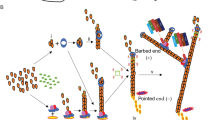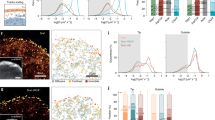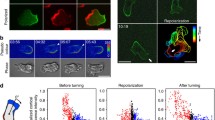Abstract
Recently we described a new phenomenon of anodotropic pseudopod-like blebbing in U937 cells exposed to nanosecond pulsed electric field (nsPEF). In Ca2+-free buffer such exposure initiates formation of pseudopod-like blebs (PLBs), protrusive cylindrical cell extensions that are distinct from apoptotic and necrotic blebs. PLBs nucleate predominantly on anode-facing cell pole and extend toward anode during nsPEF exposure. Bleb extension depends on actin polymerization and availability of actin monomers. Inhibition of intracellular Ca2+, cell contractility, and RhoA produced no effect on PLB initiation. Meanwhile, inhibition of WASP by wiskostatin causes dose-dependent suppression of PLB growth. Soon after the end of nsPEF exposure PLBs lose directionality of growth and then retract. Microtubule toxins nocodazole and paclitaxel did not show immediate effect on PLBs; however, nocodazole increased mobility of intracellular components during PLB extension and retraction. Retraction of PLBs is produced by myosin activation and the corresponding increase in PLB cortex contractility. Inhibition of myosin by blebbistatin reduces retraction while inhibition of RhoA–ROCK pathway by Y-27632 completely prevents retraction. Contraction of PLBs can produce cell translocation resembling active cell movement. Overall, the formation, properties, and life cycle of PLBs share common features with protrusions associated with ameboid cell migration. PLB life cycle may be controlled through activation of WASP by its upstream effectors such as Cdc42 and PIP2, and main ROCK activator—RhoA. Parallels between pseudopod-like blebbing and motility blebbing may provide new insights into their underlying mechanisms.








Similar content being viewed by others
References
Amano, M., Ito, M., Kimura, K., Fukata, Y., Chihara, K., Nakano, T., et al. (1996). Phosphorylation and activation of myosin by Rho-associated kinase (Rho-kinase). Journal of Biological Chemistry, 271(34), 20246–20249.
Barros, L. F., Kanaseki, T., Sabirov, R., Morishima, S., Castro, J., Bittner, C. X., et al. (2003). Apoptotic and necrotic blebs in epithelial cells display similar neck diameters but different kinase dependency. Cell Death and Differentiation, 10(6), 687–697.
Bergert, M., Chandradoss, S. D., Desai, R. A., & Paluch, E. (2012). Cell mechanics control rapid transitions between blebs and lamellipodia during migration. Proceedings of the National Academy of Sciences, 109(36), 14434–14439.
Blaser, H., Reichman-Fried, M., Castanon, I., Dumstrei, K., Marlow Florence, L., Kawakami, K., et al. (2006). Migration of zebrafish primordial germ cells: A role for myosin contraction and cytoplasmic flow. Developmental Cell, 11(5), 613–627.
Bowman, A., Nesin, O., Pakhomova, O., & Pakhomov, A. (2010). Analysis of plasma membrane integrity by fluorescent detection of Tl(+) uptake. Journal of Membrane Biology, 236(1), 15–26.
Bubb, M. R., Senderowicz, A. M., Sausville, E. A., Duncan, K. L., & Korn, E. D. (1994). Jasplakinolide, a cytotoxic natural product, induces actin polymerization and competitively inhibits the binding of phalloidin to F-actin. Journal of Biological Chemistry, 269(21), 14869–14871.
Bubb, M. R., Spector, I., Beyer, B. B., & Fosen, K. M. (2000). Effects of jasplakinolide on the kinetics of actin polymerization: An explanation for certain in vivo observations. Journal of Biological Chemistry, 275(7), 5163–5170.
Bustelo, X. R., Sauzeau, V., & Berenjeno, I. M. (2007). GTP-binding proteins of the Rho/Rac family: regulation, effectors and functions in vivo. BioEssays, 29(4), 356–370.
Campellone, K. G., & Welch, M. D. (2010). A nucleator arms race: cellular control of actin assembly. Nature Reviews Molecular Cell Biology, 11(4), 237–251.
Charras, G. T. (2008). A short history of blebbing. Journal of Microscopy, 231(3), 466–478.
Charras, G. T., Hu, C.-K., Coughlin, M., & Mitchison, T. J. (2006). Reassembly of contractile actin cortex in cell blebs. The Journal of Cell Biology, 175(3), 477–490.
Charras, G., & Paluch, E. (2008). Blebs lead the way: How to migrate without lamellipodia. Nature Reviews Molecular Cell Biology, 9(9), 730–736.
Coué, M., Brenner, S. L., Spector, I., & Korn, E. D. (1987). Inhibition of actin polymerization by latrunculin A. FEBS Letters, 213(2), 316–318.
Cunningham, C. C. (1995). Actin polymerization and intracellular solvent flow in cell surface blebbing. The Journal of Cell Biology, 129(6), 1589–1599.
Deacon, S. W., & Peterson, J. R. (2008). Chemical inhibition through conformational stabilization of Rho GTPase effectors. In E. Klussmann & J. Scott (Eds.), Protein–protein interactions as new drug targets (Vol. 186, pp. 431–460)., Handbook of Experimental Pharmacology Berlin Heidelberg: Springer.
Eitaki, M., Yamamori, T., Meike, S., Yasui, H., & Inanami, O. (2012). Vincristine enhances amoeboid-like motility via GEF-H1/RhoA/ROCK/Myosin light chain signaling in MKN45 cells. BMC Cancer, 12(1), 469.
Etienne-Manneville, S. (2004). Cdc42—the centre of polarity. Journal of Cell Science, 117(8), 1291–1300.
Etienne-Manneville, S., & Hall, A. (2002). Rho GTPases in cell biology. Nature, 420(6916), 629–635.
Fackler, O. T., & Grosse, R. (2008). Cell motility through plasma membrane blebbing. The Journal of Cell Biology, 181(6), 879–884.
Friedl, P., & Wolf, K. (2003). Proteolytic and non-proteolytic migration of tumour cells and leucocytes. Biochemical Society Symposia, 70, 277–285.
Friedl, P., & Wolf, K. (2003). Tumour-cell invasion and migration: Diversity and escape mechanisms. Nature Reviews Cancer, 3(5), 362–374.
Fukata, Y., Kaibuchi, K., & Amano, M. (2001). Rho–Rho-kinase pathway in smooth muscle contraction and cytoskeletal reorganization of non-muscle cells. Trends in Pharmacological Sciences, 22(1), 32–39.
Gadea, G., Sanz-Moreno, V., Self, A., Godi, A., & Marshall, C. J. (2008). DOCK10-mediated Cdc42 activation is necessary for amoeboid invasion of melanoma cells. Current Biology, 18(19), 1456–1465.
Ganguly, A., Yang, H., Sharma, R., Patel, K. D., & Cabral, F. (2012). The role of microtubules and their dynamics in cell migration. Journal of Biological Chemistry, 287(52), 43359–43369.
Gass, G. V., & Chernomordik, L. V. (1990). Reversible large-scale deformations in the membranes of electrically-treated cells: Electroinduced bleb formation. Biochimica et Biophysica Acta (BBA)–Biomembranes, 1023(1), 1–11.
Guerriero, C. J., & Weisz, O. A. (2007). N-WASP inhibitor wiskostatin nonselectively perturbs membrane transport by decreasing cellular ATP levels. American Journal of Physiology–Cell Physiology, 292(4), C1562–C1566.
Hummel, I., Klappe, K., Ercan, C., & Kok, J. W. (2011). Multidrug resistance-related protein 1 (MRP1) function and localization depend on cortical actin. Molecular Pharmacology, 79(2), 229–240.
Jordan, M. A., Toso, R. J., Thrower, D., & Wilson, L. (1993). Mechanism of mitotic block and inhibition of cell proliferation by taxol at low concentrations. Proceedings of the National Academy of Sciences, 90(20), 9552–9556.
Kardash, E., Reichman-Fried, M., Maitre, J.-L., Boldajipour, B., Papusheva, E., Messerschmidt, E.-M., et al. (2010). A role for Rho GTPases and cell–cell adhesion in single-cell motility in vivo. Nature Cell Biology, 12(1), 47–53.
Keely, P. J., Westwick, J. K., Whitehead, I. P., Der, C. J., & Parise, L. V. (1997). Cdc42 and Rac1 induce integrin-mediated cell motility and invasiveness through PI(3)K. Nature, 390(6660), 632–636.
Kimura, K., Ito, M., Amano, M., Chihara, K., Fukata, Y., Nakafuku, M., et al. (1996). Regulation of myosin phosphatase by Rho and Rho-associated kinase (Rho-kinase). Science, 273(5272), 245–248.
Kovács, M., Tóth, J., Hetényi, C., Málnási-Csizmadia, A., & Sellers, J. R. (2004). Mechanism of blebbistatin inhibition of myosin II. Journal of Biological Chemistry, 279(34), 35557–35563.
Lammermann, T., Bader, B. L., Monkley, S. J., Worbs, T., Wedlich-Soldner, R., Hirsch, K., et al. (2008). Rapid leukocyte migration by integrin-independent flowing and squeezing. Nature, 453(7191), 51–55.
Lämmermann, T., Renkawitz, J., Wu, X., Hirsch, K., Brakebusch, C., & Sixt, M. (2009). Cdc42-dependent leading edge coordination is essential for interstitial dendritic cell migration. Blood, 113(23), 5703–5710.
Lämmermann, T., & Sixt, M. (2009). Mechanical modes of ‘amoeboid’ cell migration. Current Opinion in Cell Biology, 21(5), 636–644.
Leung, T., Chen, X. Q., Manser, E., & Lim, L. (1996). The p160 RhoA-binding kinase ROK alpha is a member of a kinase family and is involved in the reorganization of the cytoskeleton. Molecular and Cellular Biology, 16(10), 5313–5327.
Limouze, J., Straight, A., Mitchison, T., & Sellers, J. (2004). Specificity of blebbistatin, an inhibitor of myosin II. Journal of Muscle Research and Cell Motility, 25(4), 337–341.
Martinet, W., Schrijvers, D. M., & Kockx, M. M. (2003). Nucleofection as an efficient nonviral transfection method for human monocytic cells. Biotechnology Letters, 25(13), 1025–1029.
Maugis, B., Brugues, J., Nassoy, P., Guillen, N., Sens, P., & Amblard, F. (2010). Dynamic instability of the intracellular pressure drives bleb-based motility. Journal of Cell Science, 123(22), 3884–3892.
Mills, J. C., Stone, N. L., Erhardt, J., & Pittman, R. N. (1998). Apoptotic membrane blebbing is regulated by myosin light chain phosphorylation. The Journal of Cell Biology, 140(3), 627–636.
Mitchison, T. J., Charras, G. T., & Mahadevan, L. (2008). Implications of a poroelastic cytoplasm for the dynamics of animal cell shape. Seminars in Cell & Developmental Biology, 19(3), 215–223.
Pakhomov, A. G., Shevin, R., White, J. A., Kolb, J. F., Pakhomova, O. N., Joshi, R. P., et al. (2007). Membrane permeabilization and cell damage by ultrashort electric field shocks. Archives of Biochemistry and Biophysics, 465(1), 109–118.
Paluch, E., Piel, M., Prost, J., Bornens, M., & Sykes, C. (2005). Cortical actomyosin breakage triggers shape oscillations in cells and cell fragments. Biophysical Journal, 89(1), 724–733.
Paluch, E., Sykes, C., Prost, J., & Bornens, M. (2006). Dynamic modes of the cortical actomyosin gel during cell locomotion and division. Trends in Cell Biology, 16(1), 5–10.
Parri, M., & Chiarugi, P. (2010). Rac and Rho GTPases in cancer cell motility control. Cell Communication and Signal, 8, 23.
Parri, M., Taddei, M. L., Bianchini, F., Calorini, L., & Chiarugi, P. (2009). EphA2 reexpression prompts invasion of melanoma cells shifting from mesenchymal to amoeboid-like motility style. Cancer Research, 69(5), 2072–2081.
Paul, B. Z. S., Daniel, J. L., & Kunapuli, S. P. (1999). Platelet shape change is mediated by both calcium-dependent and -independent signaling pathways: Role of p160 Rho-associated coiled-coil-containing protein kinase in platelet shape change. Journal of Biological Chemistry, 274(40), 28293–28300.
Peterson, J. R., Bickford, L. C., Morgan, D., Kim, A. S., Ouerfelli, O., Kirschner, M. W., et al. (2004). Chemical inhibition of N-WASP by stabilization of a native autoinhibited conformation. Nature Structural & Molecular Biology, 11(8), 747–755.
Petrie, R. J., Gavara, N., Chadwick, R. S., & Yamada, K. M. (2012). Nonpolarized signaling reveals two distinct modes of 3D cell migration. The Journal of Cell Biology, 197(3), 439–455.
Pollard, T. D., & Borisy, G. G. (2003). Cellular motility driven by assembly and disassembly of actin filaments. Cell, 112(4), 453–465.
Raftopoulou, M., & Hall, A. (2004). Cell migration: Rho GTPases lead the way. Developmental Biology, 265(1), 23–32.
Rassokhin, M., & Pakhomov, A. (2012). Electric field exposure triggers and guides formation of pseudopod-like blebs in U937 monocytes. Journal of Membrane Biology, 245(9), 521–529.
Renkawitz, J., & Sixt, M. (2010). Mechanisms of force generation and force transmission during interstitial leukocyte migration. EMBO Reports, 11(10), 744–750.
Ridley Anne, J. (2011). Life at the leading edge. Cell, 145(7), 1012–1022.
Ridley, A. J., Paterson, H. F., Johnston, C. L., Diekmann, D., & Hall, A. (1992). The small GTP-binding protein Rac regulates growth factor-induced membrane ruffling. Cell, 70(3), 401–410.
Rohatgi, R., Ma, L., Miki, H., Lopez, M., Kirchhausen, T., Takenawa, T., et al. (1999). The interaction between N-WASP and the Arp2/3 complex links Cdc42-dependent signals to actin assembly. Cell, 97(2), 221–231.
Rottner, K., Hall, A., & Small, J. V. (1999). Interplay between Rac and Rho in the control of substrate contact dynamics. Current Biology, 9(12), S640–S641.
Sahai, E., & Marshall, C. J. (2003). Differing modes of tumour cell invasion have distinct requirements for Rho/ROCK signalling and extracellular proteolysis. Nature Cell Biology, 5(8), 711–719.
Salbreux, G., Charras, G., & Paluch, E. (2012). Actin cortex mechanics and cellular morphogenesis. Trends in Cell Biology, 22(10), 536–545.
Sanz-Moreno, V. (2012). Tumour invasion: A new twist on Rac-driven mesenchymal migration. Current Biology, 22(11), R449–R451.
Sanz-Moreno, V., Gadea, G., Ahn, J., Paterson, H., Marra, P., Pinner, S., et al. (2008). Rac activation and inactivation control plasticity of tumor cell movement. Cell, 135(3), 510–523.
Schoenbach, K. H., Hargrave, B., Joshi, R. P., Kolb, J. F., Nuccitelli, R., Osgood, C., et al. (2007). Bioelectric effects of intense nanosecond pulses, dielectrics and electrical insulation. IEEE Transactions, 14(5), 1088–1109.
Semenov, I., Xiao, S., & Pakhomov, A. G. (2012). Primary pathways of intracellular Ca(2+) mobilization by nanosecond pulsed electric field. Biochimica et Biophysica Acta (BBA)–Biomembranes (0), 1828(3), 981–989.
Steffen, A., Rottner, K., Ehinger, J., Innocenti, M., Scita, G., Wehland, J., et al. (2004). Sra-1 and Nap1 link Rac to actin assembly driving lamellipodia formation. EMBO Journal, 23(4), 749–759.
Takesono, A., Heasman, S. J., Wojciak-Stothard, B., Garg, R., & Ridley, A. J. (2010). Microtubules regulate migratory polarity through Rho/ROCK signaling in T cells. PLoS ONE, 5(1), e8774.
Tan, J. L., Ravid, S., & Spudich, J. A. (1992). Control of nonmuscle myosins by phosphorylation. Annual Review of Biochemistry, 61(1), 721–759.
Tekle, E., Wolfe, M. D., Oubrahim, H., & Chock, P. B. (2008). Phagocytic clearance of electric field induced ‘apoptosis-mimetic’ cells. Biochemical and Biophysical Research Communications, 376(2), 256–260.
Tsong, T. Y. (1991). Electroporation of cell membranes. Biophysical Journal, 60(2), 297–306.
Vega, F. M., Fruhwirth, G., Ng, T., & Ridley, A. J. (2011). RhoA and RhoC have distinct roles in migration and invasion by acting through different targets. The Journal of Cell Biology, 193(4), 655–665.
Vicente-Manzanares, M., Ma, X., Adelstein, R. S., & Horwitz, A. R. (2009). Non-muscle myosin II takes centre stage in cell adhesion and migration. Nature Reviews Molecular Cell Biology, 10(11), 778–790.
White, J. A., Blackmore, P. F., Schoenbach, K. H., & Beebe, S. J. (2004). Stimulation of capacitative calcium entry in HL-60 cells by nanosecond pulsed electric fields. Journal of Biological Chemistry, 279(22), 22964–22972.
Wolf, K., Mazo, I., Leung, H., Engelke, K., von Andrian, U. H., Deryugina, E. I., et al. (2003). Compensation mechanism in tumor cell migration. The Journal of Cell Biology, 160(2), 267–277.
Wolf, K., Müller, R., Borgmann, S., Bröcker, E.-B., & Friedl, P. (2003). Amoeboid shape change and contact guidance: T-lymphocyte crawling through fibrillar collagen is independent of matrix remodeling by MMPs and other proteases. Blood, 102(9), 3262–3269.
Yam, P. T., Wilson, C. A., Ji, L., Hebert, B., Barnhart, E. L., Dye, N. A., et al. (2007). Actin–myosin network reorganization breaks symmetry at the cell rear to spontaneously initiate polarized cell motility. The Journal of Cell Biology, 178(7), 1207–1221.
Yoshida, K., & Soldati, T. (2006). Dissection of amoeboid movement into two mechanically distinct modes. Journal of Cell Science, 119(18), 3833–3844.
Author information
Authors and Affiliations
Corresponding author
Rights and permissions
About this article
Cite this article
Rassokhin, M.A., Pakhomov, A.G. Cellular Regulation of Extension and Retraction of Pseudopod-Like Blebs Produced by Nanosecond Pulsed Electric Field (nsPEF). Cell Biochem Biophys 69, 555–566 (2014). https://doi.org/10.1007/s12013-014-9831-9
Published:
Issue Date:
DOI: https://doi.org/10.1007/s12013-014-9831-9




